#Rowan Tucker Meyer
Text
CAST LIST
Laurie Gryffon--------------------------------------------Elizabeth Afton
Grayson Miller-------------------------------------------------Evan Afton
Kit Miller----------------------------------------------------Michael Afton
Mrs. Miller----------------------------------------------------------Ballora
Allen Carter--------------------------------------------------------Bonbon
Maria/Remi--------------------------------------------------------Bonnet
Dr. Meyer----------------------------------------------------Susie Denver
Kennedy Miller----------------------------------------------Charlie Emily
Hudson Carter--------------------------------------------Freddy Fazbear
Sunny Meadows---------------------------------------Jeremy Fitzgerald
Blair Cohen--------------------------------------------Vanessa Fitzgerald
Levi Gryffon-----------------------------------------------------Noah Fox
Rowan-------------------------------------------------------------F.T. Foxy
Ace Gryffon----------------------------------------------------F.T. Freddy
Logan Samuals---------------------------------------Montgomery Gator
Luna Frost------------------------------------------------Chica Glamrock
Tucker Hill---------------------------------------------------------Gregory
Tyler Graham--------------------------------------------------Simon Grey
Myles------------------------------------------------------------Jeremy H.
August--------------------------------------------------------------Fritz K.
Kai Wales--------------------------------------------------------Mark Katz
Luka/Chase------------------------------------------------------Brooks L.
Nyx Bartlett---------------------------------------------------------Lolbit
Leilana West-------------------------------------------------------Mangle
Serenity Ellis-------------------------------------------------Minireena #1
Teenager-----------------------------------------------------Minireena #2
Bartender----------------------------------------------------Minireena #3
Professor Monroe----------------------------------------------Moondrop
Gage Andrews--------------------------------------------Fredrick Robins
Weston/Austin-------------------------------------------Bonnie Rockstar
Rebel Bexley------------------------------------------------Cassidy Rose
Oliver Gillian---------------------------------------------------Fritz Smith
Mr. Miller---------------------------------------------------------Sunshine
Skylar Quinn------------------------------------------------Roxanne Wolf
#fnaf high school au#fnaf fandom#fnaf fanfic#high school au#theater au#five nights at freddy's#the afton kids#jeremike#cast list#Im literally writing a musical solely for this story
2 notes
·
View notes
Text
The Oscar Worthiness of BLOCK-HEADS By Rowan Tucker-Meyer

In this year’s 31 Days of Oscar lineup (also available on WatchTCM), among all of the classics we’ve watched and rewatched many times, there is one movie that may at first glance appear to be slightly out of place: the Laurel and Hardy film BLOCK-HEADS (’38). Although it is not as well known or acclaimed, I believe that it is every bit as good as most of the other Oscar-nominated films being shown this month.
In BLOCK-HEADS, Laurel and Hardy portray, as the title suggests, two not-so-bright fellows. The film opens with footage of World War I and we meet Stan and Ollie, two soldiers in the trenches. While the rest of the company goes into battle, Stan is ordered to stay back and guard the trench. In a delightfully dark turn of events, the other soldiers never return, news of the eventual armistice never reaches Stan and he dutifully guards the trench… for 21 years. The year is now 1938, and Stan has been subsisting solely on cans of beans. We even see a humongous mountain of 21 years’ worth of bean cans; it is a haunting image. He is discovered and returned to society, and when Ollie sees his friend’s photograph in the paper he decides to invite him over for dinner. Mayhem, needless to say, ensues.
I first saw this film a few months ago and it was one of my most delightful movie-watching experiences in recent memory. I hadn’t laughed so hard at a movie in a long time. With a running length of just 57 minutes, it’s densely packed with great gags which I won’t attempt to describe here. I’ll just say that my personal favorite gag is the one involving a football and leave it at that.

BLOCK-HEADS was nominated for Best Original Score. Marvin Hatley’s score is certainly good (even if it was often difficult to hear over the sound of my uproarious laughter), but it does seem a bit odd that it’s all that BLOCK-HEADS was nominated for, since it’s just about the last thing you think about when you finish watching this movie. You’re thinking about the hilarious performances by Laurel and Hardy – their gestures and facial expressions – the way Hardy reflexively touches his hat and the way Laurel sways side to side when he’s standing around, not really knowing what to do with himself. Or maybe you’re thinking about the script with its brilliant setups and payoffs. But the actors, writers and directors of movies like BLOCK-HEADS would rarely find themselves nominated for awards.
The film’s director, John G. Blystone, was never nominated for an Oscar. Neither were any of the film’s five writers. Laurel received an honorary Oscar in 1961, but apart from that, Laurel and Hardy themselves were never nominated for anything, even though their performances have aged remarkably well. As for their films, BLOCK-HEADS and WAY OUT WEST (’37) earned Best Original Score nominations, while THE MUSIC BOX (’32) won and TIT FOR TAT (’35) was nominated for Best Live Action Short Subject, Comedy. Tellingly, their work was mainly recognized when competing in a category specifically devoted to comedy, which was discontinued in 1937. Although today Laurel and Hardy are beloved icons and many classic film lovers will agree that their films have stood the test of time, those movies simply weren’t seen as worthy of much recognition when they were first released, except in peripheral categories. (I find it amusing that, although BLOCK-HEADS had no realistic chance of getting a Best Picture nomination at the 11th Oscars, it currently has a better IMDB rating than 6 of the 10 movies that were nominated instead.)
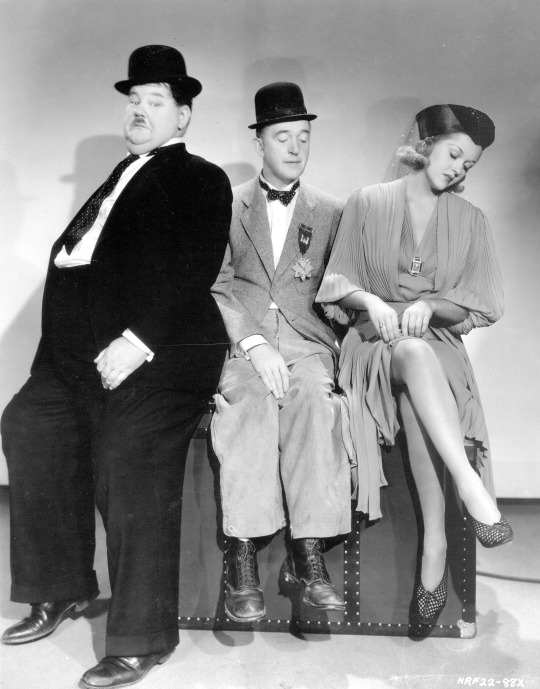
Comedies, particularly “lowbrow” comedies such as Laurel and Hardy’s slapstick-heavy movies, are seldom honored by the Oscars. The films of classic comedians such as Abbott and Costello, the Marx Brothers, Olsen and Johnson and W.C. Fields were regularly ignored. And this trend persists to the present day, perhaps to an even greater extent than in the 1930s. Best Picture nominees are notoriously drama-dominated, and the comedies that do get nominated are nearly always “comedy-dramas” like JOJO RABBIT (2019) which have an underlying seriousness at their core. Silliness for its own sake consistently goes unrewarded, whether it’s from Melissa McCarthy, Jack Black, Will Ferrell or Tyler Perry. Whether or not you think today’s comedians are comparable to those of the ‘30s and ‘40s, it is interesting to consider that Laurel and Hardy may have been viewed in their time the same way that critics receive an Adam Sandler comedy today, only for them to become respected decades later.
Great slapstick is really quite beautiful. Its humor is ageless and universal, striking some indescribable chord in our collective human psyche. What is it about Oliver Hardy slipping and falling on a rolling pin that makes us laugh? I’m not sure, but it’s hard to deny that slapstick has a mysterious power. Silliness deserves respect, especially when it is executed as exquisitely as in films like BLOCK-HEADS.
#Comedies#Oscars#academy awards#Best Song#Laurel and Hardy#1930s#slapstick#TCM#Turner Classic Movies#Rowan Tucker Meyer
61 notes
·
View notes
Text
Thank you my friend!!! On Wednesday, June 7, 2017 10:46 AM, Todd Barrow <[email protected]> wrote: On Wednesday, June 7, 2017 10:34 AM, Bruno Michel (Texas Music Time) <[email protected]> wrote: Dear all here's this week's playlist. Established in 2008, we reach more than four Million listeners every month terrestrial. We're also getting more and more attention from listeners in Texas on the web. Past four shows are always available on www.american-country.ch under "Radio Shows". Thanks for keeping them new songs coming. Bruno Show: Texas Music Time Date aired: 6/6/2017 Seq. Artist Track Album Year 1 Jack Higginbotham Better Than Being In Love With You Single Release 2012 2 Don Edwards The Hell-Bound Train American 2011 3 Darrin Morris Band Where Will I Be Single Release 2017 4 Augie Meyers Sugar Blu Monkeys On Cocaine 2017 5 Don Henley & Miranda Lambert & Mick Jagger Bramble Rose Cass County 2015 6 Abraham Weaver These Four Walls Lost And Found 2017 7 The Powell Brothers Evangeline Single Release 2017 8 Billy Mata Dev'lish Mary By Request 2012 9 Art Carter Mighty Mississippi Single Release 2017 10 Brent Giddens Worth It Worth It 2017 11 Natalie Rose Conformity Single Release 2017 12 Deryl Dodd & Matt Hillyer Drinkin' 'Bout You Long Hard Ride 2017 13 Flaco Jimenez & Peter Rowan I'm Gonna Love You Like There's No Tomorrow Flaco's Amigos 1988 14 Jared LoStracco & The Red Dirt Troubadours Small Town Texas Red Dirt Troubadours 2017 15 Jason Eady Black Jesus Jason Eady 2017 16 Gary P. Nunn Dreamer One Way Or Another 2010 17 Kylie Frey & Randy Rogers Too Bad Single Release 2017 18 Scott Coner & Tanya Tucker Maybe She Lied Single Release 2017 19 The Greencards Weather And Water Weather And Water 2005 20 Johnny Bush & Dale Watson I Gotta Get Drunk The Absolute Johnny Bush 2017 21 Reverend's Daughter Dreams Come True Single Release 2017 22 Jenni Dale Lord Band Country Rock And Roll Free Whiskey 2016 23 BRutherz Without You Where Would I Be Single Release 2017 24 Adam Carroll My Only Good Shirt Highway Prayer: A Tribute To Adam Carroll 2016 25 Todd Barrow Guadalupe River Single Release 2016 26 Willie Nelson Still Not Dead God's Problem Child 2017 27 Shane Smith & The Saints New Orleans Geronimo 2017 28 Bode Barker & Leona Williams We've Had Some Good Times Duets 2016 29 Bannon Hancock Carry Us On Through United States Of Texas 2017 CRS Station Liner CRS ID Song Bruno Michel Radio Host "Texas Music Time" on CRS US Representative for Country Radio Switzerland US Representative for CountryStyle Magazine 935 CR 4820 Kempner, TX 76539 phone: 254-547-9295 cell: 254-554-1166 email: [email protected] web: www.countryradio.ch www.countrystyle.ch
0 notes
Text
Kindertrauma: Kids in Peril By Rowan Tucker-Meyer

A poisoned pie. A malevolent preacher. A burial in the garden. These are just a few of the ghastly things children encounter in the films featured in TCM’s day of “Kindertrauma” movies (films about some very unlucky children in distressing situations). There are many delightfully unsettling movies in today’s lineup, but my personal favorites are THE NANNY (1965), THE NIGHT OF THE HUNTER (1955) and OUR MOTHER’S HOUSE (1967).
THE NANNY is a queasy little film about tensions between a married couple, their son and the family’s nanny, played by Bette Davis. Following the success of What Ever Happened to Baby Jane? (1962), Davis appeared in a number of horror films including this one, and she consistently brought the same complexity and pathos of her “conventional” performances to her horror roles. As “Nanny” (she is never referred to by any other name), Davis gives a beautifully tense performance; she’s always a little too perfect, too composed.

Tension arises from the ambiguity surrounding the character of Joey (William Dix), the disturbed 10-year-old boy who is convinced that Nanny is trying to kill him. The audience is never quite sure if we should believe Joey or if he is simply a brat who enjoys tormenting a kind old woman. THE NANNY perfectly captures the pain of being a child in a grown-up world – Joey has no power over his own life and nobody will listen to him – and since very little about Nanny is revealed until the end of the film, the audience occasionally finds ourselves siding with the adults. In this way, it is as if we are complicit in Joey’s pain, which makes the film even more frightening.
There is no such ambiguity in THE NIGHT OF THE HUNTER. From the moment Harry Powell (Robert Mitchum) is introduced, he is undoubtedly up to no good. A self-proclaimed preacher, Powell has a history of murdering widows for their money, and his latest target is Willa Harper (Shelley Winters), whose husband Ben has recently been executed for killing two people during a bank robbery. Powell intends to find the money Ben stole, but nobody knows where it is hidden. Nobody except for Willa’s children, John (Billy Chapin) and Pearl (Sally Jane Bruce), who pose a formidable obstacle to Powell’s plan.
As in THE NANNY, the young boy John is much more perceptive than the adults, who all find Powell very charming, and John’s discernment is mistaken for rudeness. For nearly the entire movie, John is betrayed by adults, whose pettiness and gullibility put him and Pearl in serious danger. John and Pearl have to rely on each other until the third act of the film, when they finally meet an adult who recognizes the intelligence and worth of children. THE NIGHT OF THE HUNTER is truly unforgettable, with countless great scenes and great performances, and it is rightly, and only recently, considered one of the best films ever made.

OUR MOTHER’S HOUSE, on the other hand, is a great movie which has not received the recognition it deserves. OUR MOTHER’S HOUSE tells the story of seven children whose single mother has died. In order to avoid the orphanage, they decide to keep their mother’s death a secret and continue their lives as if nothing has changed. For some time, they are able to survive and take care of each other while concealing their mother’s death, but it’s only so long before an unexpected visitor puts their way of life in jeopardy. In addition to the lovely autumn atmosphere, what really makes OUR MOTHER’S HOUSE exceptional is its excellent ensemble cast. It is a rare occurrence when a film features seven child actors who are all strong performers, but the children of OUR MOTHER’S HOUSE manage to be consistently convincing. The standout is Pamela Franklin, whose performance as the fanatical, seance-conducting Diana is at times rather terrifying (Franklin also appears in THE NANNY as Joey’s friend Bobbie).

Although these films are very dark and disturbing, they are ultimately quite uplifting as well. The children are in traumatic situations, but the films focus on more than just their trauma. They examine how the children respond to that trauma, and those responses are often strikingly beautiful. During times of crisis and in the absence of a responsible authority, these children are not hopeless or selfish. They are resilient, resourceful, determined, clever and unafraid to tell the truth, even when nobody else will. Above all, they take care of each other. It is this, as much as the horror and suspense, that makes these films so powerful. These children are deeply inspiring and we can all learn from their example.
#Child actors#children#kids#movie kids#classic movie kids#old hollywood#thriller#horror#Bette Davis#Robert Mitchum#TCM#Turner Classic Movies#The Nanny#Night of the Hunter#Our Mother's House#Rowan Tucker-Meyer
82 notes
·
View notes
Text
Politics and Organizing in Film By Rowan Tucker-Meyer
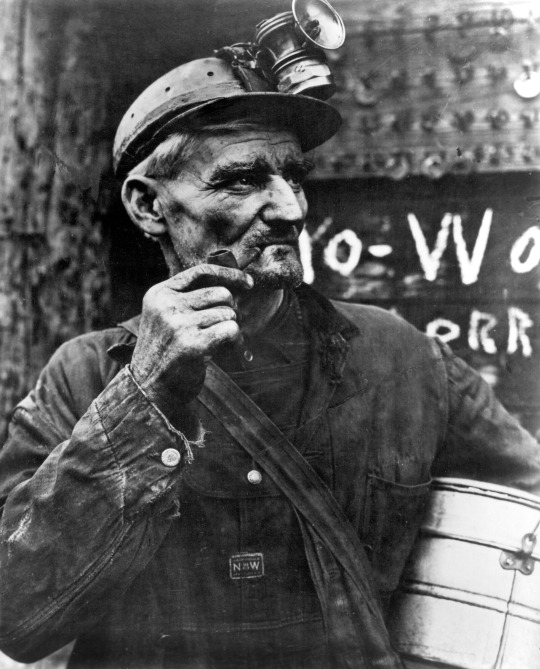
As part of its incredible three-month lineup of films directed by women, TCM is showing the unforgettable documentary HARLAN COUNTY, U.S.A. (‘76), directed by Barbara Kopple. HARLAN COUNTY, U.S.A., which chronicles a strike by miners at the Brookside Mine in Harlan County, Kentucky, is a stunning film. It is a documentary, yes, but its story has all the action, pathos and suspense of a Hollywood drama. It is filled with characters and moments that will stick with you long after the credits roll, and it is just as necessary today as it was in 1976.
The first word that comes to my mind when I think about HARLAN COUNTY, U. S.A.is courage, primarily because it is an unapologetically political film. It depicts the struggle between miners striking for a new contract and the Duke Power Company, which refuses to sign the contract. Kopple is not afraid to take sides, and her film is pro-worker through and through. As Kopple once said, “I’m a politician first, a filmmaker second.” This attitude is present throughout her body of work; in addition to workers’ rights, Kopple has made films about immigration law, American gun culture, the AIDS crisis and women’s rights throughout the world. For Kopple, making documentaries is a form of activism. She does not intend to simply educate the audience, but also to inspire them to take action. She once described HARLAN COUNTY, U.S.A.as not just a great film, but a “great organizing tool” as well.
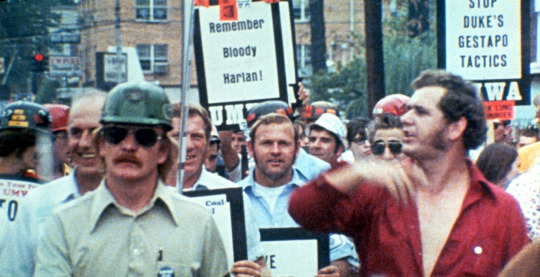
It also took a lot of courage for Kopple to live and work for 13 months in such a tense and often dangerous environment. Kopple and her crew quite literally risked their lives to make this movie, as we see in one unbelievable scene where they are shot at and knocked down by strikebreakers. “I found out later that they planned to kill us that day,” Kopple recounted in a discussion with Roger Ebert. “They wanted to knock us out because they didn’t want a record of what was happening.” Furthermore, it was courageous of her to make a film about a subject and a group of people that moviegoers generally prefer to ignore and that movie distributors would not consider to be particularly marketable. If we ever see working-class Appalachia depicted on screen, it’s usually stereotypical caricatures instead of real people. Kopple, however, shows us real people and lets them tell their stories and speak their minds. The film is, more than anything else, about the people of Harlan County, and Kopple presents them with immense compassion.
Among the many compelling people we meet throughout the film, the most memorable heroes are the miners’ wives, who are some of the most important organizers of the strike. When we hear about striking coal workers, we generally assume that the effort is entirely directed by a predominantly male group of miners. However, Kopple reminds us that women, even those who do not work in the mines, are always a crucial part of the struggle as well, and she devotes much of the film to highlighting their contributions. Many of the film’s most indelible moments center around women.

The most powerful scene in the film is when Florence Reece, a septuagenarian activist and songwriter, addresses a huge crowd of miners and sings her legendary protest song “Which Side Are You On?” It’s hard not to be moved by watching Reece sing this song, which is simple, yet fiercely confrontational and emblematic of the determination of the striking workers. As we will see throughout TCM’s series of female-directed films, these directors are important not only because they’re brilliant directors, but also because they choose to emphasize the stories of women, like Florence Reece and the other organizers of Harlan County, women whose stories are not always told.
Although the Brookside mine strike has been over for decades, HARLAN COUNTY, U.S.A.still feels remarkably alive. More than just a historical document, the film beautifully captures the energy of this particular place and time. It captures the passion, the anger and the fear in Harlan County. It captures what it felt like to be in the mines and on the picket lines. It raises issues that still need to be addressed and questions that still need to be asked. It was a groundbreaking film, not just for female directors, but for the documentary genre itself, and it is just as fresh and important today as ever.
#Harlan County U.S.A.#Barbara Kopple#women directors#Women Make Film#female filmmakers#TCM#documentary#strike#union#Turner Classic Movies#Rowan Tucker-Meyer
66 notes
·
View notes
Text
YI YI: A Truly Special Movie By Rowan Tucker-Meyer

The last movie by acclaimed Taiwanese filmmaker Edward Yang, YI YI (2000) is a film of exceptional beauty, depth, empathy, humor and love. It is not a simple task to concisely describe its story, except to say that it is about a family living in Taipei, and that it follows the stories of each member of the family and the ways in which they try to make sense of the world. There are three central characters who are entwined in a larger web of other major characters, creating an intricate tapestry of relationships and events.
YI YI could have easily been convoluted if not for Yang’s masterful direction and his exquisitely constructed screenplay, which weaves in and out of the different characters and storylines so elegantly that you barely ever notice how complex the film really is. “Epic” would be an appropriate word to describe this film, except that there is nothing at all epic about these people or their experiences. Their lives and struggles are for the most part quite ordinary, and yet there’s not a moment of this nearly three-hour-long film that isn’t compelling.
Upon reflecting on YI YI, it’s remarkable to realize how little “plot” there actually is. Yang is not a director who is concerned with tight storytelling. Instead, he allows the story to breathe and follow a natural pace. He is also not too concerned with conventional structure. Rather than a series of plot points, YI YI is composed of a number of magnificent little moments. I would even go so far as to say that there are a handful of perfect scenes.

The first of these comes when the protagonist, N.J. (Nien-Jen Wu), has a chance encounter with his high school lover, who he has not seen since he left her without a word almost 30 years ago. Another is when N.J. discusses music with Japanese businessman Ota (Issei Ogata, who has to be one of the loveliest characters in any movie) and takes him to a karaoke bar. And then there is the scene where N.J.’s brother-in-law, A-Di (Xisheng Chen), throws a party to celebrate the birth of his son, but the presence of an uninvited guest leads to a brawl. These scenes are simply beautiful, particularly in the way that they gracefully combine pathos and humor, which Yang does throughout the film.
Much of the runtime is also devoted to the development of the audience’s deep understanding of these characters. There are several major characters, but Yang’s depiction of each of them is so thoughtful and detailed that he manages to make them all feel real. It’s also impressive how many characters have complete, meaningful story arcs. By the time the credits roll, it feels like we genuinely know these people. Even the most minor characters feel authentic, like the bartender at the karaoke bar who tells N.J. about his troubles, or A-Di’s boisterous buddy Migo (Yungfeng Li).
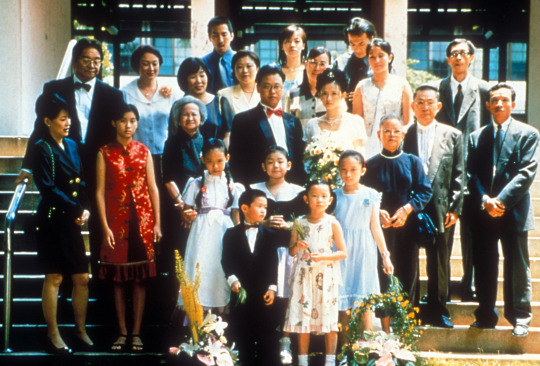
Although we are only given brief glimpses into these people’s lives, we understand them very well. Yang is a tremendously empathetic filmmaker, and his love for his characters is evident in every moment of the film. These characters certainly have flaws, but Yang loves them and makes his audience love them too. I know very little about Edward Yang as a person, but one gets the impression from this film that he was a very compassionate man with a sincere love for humanity.
Additionally, the film is full of brilliant performances. The actors in YI YI manage to be completely captivating while acting with great subtlety. (It’s especially enjoyable to watch the scenes with large groups of characters, because on each subsequent viewing, your eye is drawn to a great actor that you haven’t noticed before.) Perhaps the most extraordinary performance is that of Jonathan Chang, who played the character of Yang-Yang, N.J.’s son, when he was just nine years old. Yang-Yang is one of the central characters and a lot of time is spent on him, which can be a major risk with such a young actor. However, his portrayal of Yang-Yang is possibly one of the greatest child performances ever. He is stunningly natural. It is so refreshing to see a kid who acts like a kid. Yang-Yang is smart, but he’s smart in the way that a real child would be, and he narrowly avoids becoming irritatingly precocious like so many movie kids.
YI YI is one of my very favorite movies, and it is such a delight that TCM Imports has decided to show it. If you’d like to see a film that’s moving, funny and ultimately very uplifting, don’t miss YI YI.
#Yi Yi#Taiwan#Taiwanese film#foreign film#asian representation#TCM#Turner Classic Movies#Rowan Tucker-Meyer
58 notes
·
View notes
Text
Finding Peace in the Odd and Obscure By Rowan Tucker-Meyer

TCM Underground, which shows movies every Friday night at 2am ET, is TCM’s home for odd, obscure and delightful films from outside the mainstream. This month, one of the films TCM Underground will present is THE PYRAMID (‘76), an exceedingly unusual and fascinating film from director Gary Kent. You only have to look at the film’s poster to know exactly what kind of movie you’re about to watch: A woman wearing a shirt with a pyramid on it meditates in front of a larger pyramid, surrounded by a number of captivating taglines: “What does THE PYRAMID have to do with you?”; “For this engagement the theatres have been energized with pyramid power.”; “A positive mystical experience.” The poster promises a wild ride and THE PYRAMID does not disappoint.
The film opens with a sequence that is every bit as bold and surprising as the film itself. We watch as a bus driver and a number of young children start their day. They wake up, eat breakfast and head off to the school bus. Then, just as quickly as we are introduced to these characters, they are suddenly killed in a school bus crash. It is a jaw-dropping opening scene that makes the audience wonder: Did that seriously just happen? Why was this necessary? What am I watching? It’s not integral to the plot, it’s needlessly gruesome, even manipulative. But that’s exactly the point. As we come to realize, this scene is actually a perfect introduction to the issues that the protagonist, Chris Lowe (Charley Brown), faces throughout the film.

Chris is a cameraman for a TV news station, and he arrives at the crash to film a segment about it. The station he works for focuses mainly on shocking tragedies and crime, and he is becoming frustrated about having to work on these stories. This scene is representative of the kind of ugly sensationalism that Chris is used to producing, and the audience, so upset by this scene, comes to empathize with his disillusionment. When considered within this context, the opening sequence is actually quite brilliant. Like the whole film, it is a bit over-the-top and strange, but it ultimately has something thought-provoking to say.
Chris tries to break from the status quo by filming more interesting, hopeful stories. His subjects include a man who walks on fire and believes himself to have healing powers, an astronaut who discusses the possibility of intelligent extraterrestrial life and a man who constructs wooden pyramids that may “have an effect on our consciousness.” While his television station presents the bleakness and brutality of life, Chris looks for stories which suggest that perhaps people can transcend the grim reality and experience something beautiful and mysterious.
Everyone he works with has a cynical worldview, but his work is reflective of an abnormal optimism. One of these cynical colleagues is Chris’ best friend, reporter LaMoine Peabody aka L.A. Ray (a standout performance by Ira Hawkins). While Chris tries to improve or escape the TV news industry, LaMoine embraces it, becoming more successful and constantly watching himself on TV. As LaMoine becomes more deeply invested in his career and Chris searches for something better, we see their lives diverge: Chris eventually finds peace, but LaMoine’s story ends in tragedy.

There’s a lot to like about THE PYRAMID. It’s a very groovy movie, filled with a lovely 1970s atmosphere. It has a point of view and explores some unique themes that aren’t often depicted on film. It’s sometimes funny, sometimes disturbing, occasionally confusing, but always interesting. But ultimately, the best thing about THE PYRAMID might simply be its unabashed optimism. The message of the film seems to be that, in spite of all its sadness and horror, the world still has the potential to be wonderful and people still have the potential to be good. Is it a naïve message? Maybe. But the film is so beautifully made that this message ends up being quite convincing and uplifting. In troubling times, it can be refreshing to watch a movie where people sit in a wooden pyramid and sing together as the sun goes down.
There’s a scene late in the film where Chris shows his short films to the owner of a movie theater who angrily rejects them because they lack mass appeal, calling them “a waste of time.” TCM Underground is so valuable because it has the exact opposite attitude. It celebrates the weird, the independent, the overlooked. And for those of us who love those movies, THE PYRAMID is a real treat.
#The Pyramid#1970s#cult#underground#TCM Underground#TCM#Turner Classic Movies#Rowan Tucker-Meyer#positive#peace
41 notes
·
View notes
Text
Jazz and Blues: Pete Kelly’s Blues (’55) by Rowan Tucker-Meyer

As we spend the month of January celebrating the start of the 2020s and looking towards the future, TCM is showing movies every Wednesday night that depict the life and culture of the 1920s. One of the films being shown in this spotlight is a beautiful, overlooked film called PETE KELLY’S BLUES (‘55). Based on a short-lived radio show, it tells the story of Pete Kelly (played by Jack Webb, who was also the film’s director and producer), a jazz cornetist who plays with his band at a speakeasy in Kansas City. The film is rich in 1920s atmosphere and contains all of the classic tropes that characterized the era: the gangsters, the flappers, the speakeasies and, most importantly, the music.
Although not exactly a musical, music is central to PETE KELLY’S BLUES. The film opens with a scene of a New Orleans jazz funeral, and though it is only tangentially related to the film’s narrative, this scene sets up one of the key themes of PETE KELLY’S BLUES: Jazz is a music of pain and grief, but it takes these negative feelings and infuses them with an attitude of perseverance, transforming them into a source of joy and hope. Pete Kelly lives a sad and lonely life, but his music gives him solace. (The term “blues” in the film’s title refers both to the music which gives him purpose and the troubles that haunt his life; these two things are represented by one word because they are so inextricably linked.) He has developed a tough-guy persona to cope with the toughness of prohibition, but this makes it even more difficult for him to deeply connect with anyone or anything but his music. Late in the film, a character remarks, “You don’t want to get married, Pete, unless you find a girl who looks like a cornet.”
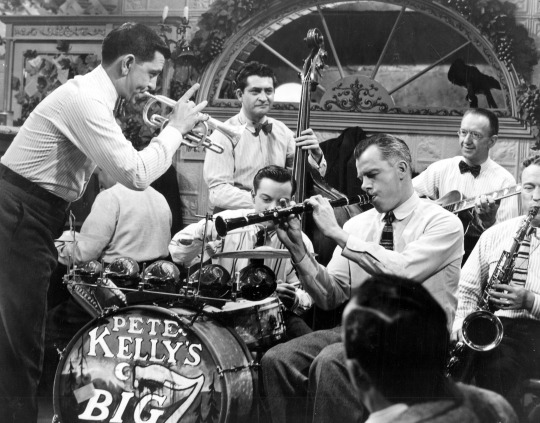
But even his music can no longer bring him happiness when his artistic freedom becomes stifled by the gangsters who control everything and push him around. Films set in the prohibition era tend to romanticize it, and while PETE KELLY’S BLUES is certainly filled with the exuberant energy that we associate with the period, it also goes deeper than that. It doesn’t shy away from the darkness. It shows us the serious economic and moral dilemmas that arose during prohibition. We see how, beneath the carefree veneer of jazz and alcohol, there is an ominous sense of foreboding that infects the nightclub where Pete plays. The film contains a few passing references to World War I, and we get the impression that the aftermath of the war has left these characters with a real feeling of hopelessness. The music is cheerful, but for both the musicians and the listeners the cheerfulness conceals deep fear. Its unrelenting frivolity eventually serves as a cruel counterpoint to the bleakness of Pete’s situation.
The music itself is excellent. Most of the music in the film is provided by Pete Kelly’s band, but the most remarkable scenes in PETE KELLY’S BLUES are the vocal performances by Peggy Lee and Ella Fitzgerald. Lee received an Academy Award nomination for her performance as Rose Hopkins, the alcoholic singer who Pete Kelly hires as part of his band at the behest of her gangster boyfriend. Lee performs beautifully, both as an actress and a singer, but what is especially striking about her performance is how she conveys her character through her musical numbers. Rose, like many of the characters in PETE KELLY’S BLUES, is a tragic figure, and Lee is able to reflect this tragedy in her singing. Her voice is simple, sad, wise and filled with pain. Even when the song is upbeat, there is still some resignation and world-weariness behind her smile.

And then there is Ella Fitzgerald. Fitzgerald plays Maggie Jackson, a singer who works at another speakeasy. Her character is entirely inessential to the story and she exists solely to punctuate the film with two magnificent performances. It is truly an incredible gift to see this beautiful, pristine color footage of one of the greatest singers of all time in her prime. Though not integral to the film, Fitzgerald’s scenes are simply delightful, both within the context of the film and as a historical document.
Among the many interesting films being shown as part of TCM’s spotlight on cinematic depictions of the Roaring Twenties, PETE KELLY’S BLUES is not one to be missed. It’s a lovely film and an excellent way to mark the start of the new decade.
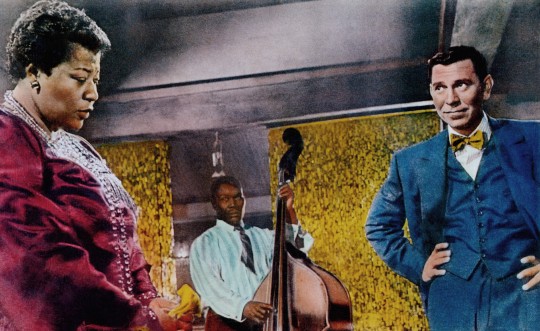
#Pete's Kelly's Blues#Jack Webb#Peggy Lee#Ella Fitzgerald#Roaring Twenties#2020#Jazz#Blues#music#Rowan Tucker-Meyer#TCM#Turner Classic Movies
53 notes
·
View notes
Text
Chantal Akerman by Rowan Tucker-Meyer
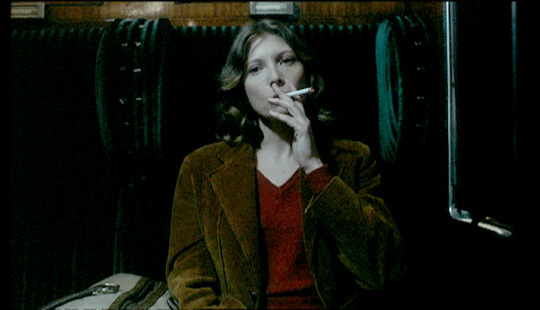
On September 21, Ava DuVernay will introduce Chantal Akerman’s remarkable film LES RENDEZ-VOUS D’ANNA (‘78) as part of TCM’s The Essentials series. This will be followed by Akerman’s experimental documentary HOTEL MONTEREY (‘73). This unique double feature will serve as an excellent introduction to her work for first-time viewers, as these two films capture what made the director so special and why her work is important.
From the very start of her career, Akerman was a radically original filmmaker. HOTEL MONTEREY, her debut feature film, is certainly an unusual movie. It consists entirely of silent footage shot in a New York City hotel. We see the hotel’s hallways, elevators, rooms and guests. HOTEL MONTEREY completely rethinks the documentary genre. It was released at a time when some documentarians were making films in the Direct Cinema style, which sought to depart from the conventions of traditional documentary filmmaking in favor of a more “objective” approach to shooting and editing. HOTEL MONTEREY, however, goes even further than the Direct Cinema movement by eliminating the constructs of character and story. By doing this, it presents these images of the hotel without any obvious message or agenda, and therefore is even more objective than Direct Cinema.

But this description doesn’t do justice to the hypnotic beauty of HOTEL MONTEREY. There’s something very special about the way that Akerman shoots this hotel. She takes something mundane and gradually turns it into something ominous. The slowness of her camera, the total silence that lasts throughout the film, the way some shots linger for just a little too long – all of this builds an unusual sort of tension. There is nothing “exciting” about this film in the ordinary sense of the word, and yet it’s hard to take your eyes off of it. As Akerman once said, “You don’t need to tell a story to make a film with a lot of tension.”
LES RENDEZ-VOUS D’ANNA, on the other hand, is a narrative film which tells the story of a film director named Anna Silver. While traveling through Europe to promote her newest film, she meets with a number of different people: family, friends, total strangers. During her conversations with these people, Anna never appears to truly care about what is being said, and these interactions are ultimately unfulfilling for her. Although she searches for genuine human connection, she is unable to find it.

Although this is a more “conventional” film than HOTEL MONTEREY, it still defies cinematic standards. Just as HOTEL MONTEREY breaks away from the traditions of the documentary genre, LES RENDEZ-VOUS D’ANNA does not at all resemble a traditional narrative film. Consider the way in which we learn about the character of Anna. Just as she feels detached from the people around her, the audience is detached from Anna and is never fully aware of what she’s thinking. She does not talk very much, and her dialogue often reveals little about her inner thoughts and feelings. The only real insight we get into her character is through the details of her face and body language (Aurore Clément, who plays Anna, gives a marvelously subtle performance). A typical protagonist would have some sort of supporting character with whom they could openly discuss their feelings and thereby explicitly convey them to the audience, but the tragedy of Anna’s character is that there is nobody in her life with whom she can truly confide – except perhaps the unseen character that Anna repeatedly tries to call but can never reach.
Even more unconventional is Akerman’s comfort with silence and long takes. Who else would choose to include a nearly two-minute-long scene of Anna laying down on the bed in her hotel room? It’s a bold choice, one that very few directors would have the audacity to shoot, but Akerman is willing to stop and just let the film breathe for a moment. This is the kind of touch that makes her films so special.

Akerman always made films that were distinctly and unquestionably her own. She rebelled against the trends of commercial filmmaking and instead made movies that served her own artistic vision. At a time when movies were becoming faster, simpler and more formulaic, she made movies that were slow, subtle and innovative. And she was doing all of this as a woman in an extremely male-dominated industry. On September 21, Ava DuVernay and TCM will celebrate Akerman’s life and work by showing LES RENDEZ-VOUS D’ANNA and HOTEL MONTEREY. These two films will show why she was so groundbreaking in her time and why she still matters today.
#chantal akerman#Hotel Monterey#ava duvernay#classics movies#foreign film#TCM#Turner Classic Movies#female director#Rowan Tucker-Meyer
29 notes
·
View notes
Text
The Emotional Intensity of Liv Ullmann by Rowan Tucker-Meyer
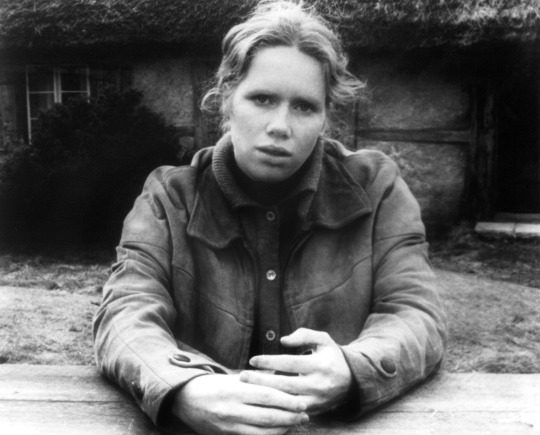
On August 14, Liv Ullmann, one of the greatest actresses of European cinema, will make her first ever appearance on TCM’s annual Summer Under The Stars programming. Eleven of her films will be shown, including the 2012 documentary LIV & INGMAR, which chronicles her artistic and romantic partnership with Ingmar Bergman, who directed her in 11 films. Four of those films will be shown on the 14th.
One of her collaborations with Bergman, AUTUMN SONATA (’78), pairs Ullmann with another great actress: Ingrid Bergman. In the film, Ingrid plays Ullmann’s somewhat estranged mother, a renowned classical pianist who has come to visit her. Over the course of one emotional, exhausting night, they try to reach a reconciliation for their anger towards one another. The film is so intense that it is almost hard to watch at times, but this is a testament to the powerful performances that drive the film. The emotional intensity of Ingmar Bergman’s screenplay would be laughable if attempted by lesser actors, but the realism that Ingrid Bergman and Ullmann bring to the characters is what creates such a harrowing experience. Though Ingrid is the film’s true star and it is her performance which ultimately dominates AUTUMN SONATA (her final film role), Ullmann delivers an excellent, nuanced performance as well.
Another one of Ullmann’s notable collaborators is Max von Sydow, who appeared with her in seven films, four of which will also be shown on the 14th. The first film in which they appeared together was HOUR OF THE WOLF (’68), another Bergman film. In this bizarre film, von Sydow plays a painter tortured by nightmares and hallucinations, and Ullmann is his concerned wife who lives with him on a small island. Once again, the extreme nature of Bergman’s screenplay works because of the strong central performances, and Ullmann and von Sydow are able to ground the film’s dream logic and dreamlike events in reality.

After HOUR OF THE WOLF, the two appeared as couples in two more Bergman films before appearing in Jan Troell’s epic two-part saga THE EMIGRANTS ('71) and THE NEW LAND ('72). These films, which have a combined running time of about six and a half hours, tell the story of Kristina and Karl Oskar Nilsson, two Swedish farmers who immigrate to America in search of a new life. THE EMIGRANTS chronicles their difficult voyage to New York and their subsequent journey from New York to Minnesota. Although it ends on a note of hope, this is merely a happy stopping place, and as the story continues in THE NEW LAND, we see the new struggles that the Nilssons face in Minnesota. It’s hard to imagine any other actors taking on the demanding roles of Kristina and Karl Oskar.
By the time they made these films, von Sydow and Ullmann had worked together for long enough to have developed a comfort with each other to believably portray a married couple. Years later, when reflecting on her work with von Sydow in these films, Ullmann said, “We knew each other so well. There was no shyness between us.” They are so natural with each other and within their own characters, that at times you forget that you’re watching a movie and lose yourself in their world.
Perhaps the most striking thing about Ullmann’s performances is how much she is able to communicate with just her face. Some of her most memorable moments in these films are silent. Consider the breathtaking scene in AUTUMN SONATA where her character Charlotte watches her mother play piano. All of her feelings about her mother—the resentment, the regret, the love—are channeled into one quiet, sad gaze. Or even the opening and closing scenes of HOUR OF THE WOLF, when she speaks directly to the camera and occasionally breaks eye contact to glance off into the distance. It is through these glances that we truly begin to understand the meaning behind her words – her deep concern for her husband, her desire to just make things the way they were before.

All too often, non-American actors don’t get the credit they truly deserve from American audiences. It can be hard for people to connect with actors and characters on screen when they’re busy reading subtitles. Even so, Ullmann’s talent transcends the language barrier, and this may be because she doesn’t depend on language as a means of expression. The fear in her eyes, the intensity of her gaze and the pain and strength of her characters resonate universally.
TCM is devoting August 14 to the films of Liv Ullmann to highlight this remarkable talent. Join us and see some of the beautiful characters she played and the great movies she made.
#Liv Ullmann#Ingrid Bergman#ingmar bergman#TCM#TCM article#Summer Under the Stars#Turner Classic Movies#foreign film#Rowan Tucker-Meyer#actress
5 notes
·
View notes
Text
The Cinematic Legacy of Martin Scorsese by Rowan Tucker-Meyer

In the early 1970s, American cinema was going through a major transformation. The abandonment of the Production Code gave freedom to filmmakers who had previously been restricted by censorship. Directors gained creative control over their films as the studio system declined. European and Asian art cinema was influencing the way that movies were being made around the world. All of these factors resulted in an era of filmmaking that transitioned classic Hollywood into American cinema as we know it today – the New Hollywood era. Directors around this time were making films that were more experimental, that challenged the norms and broke the rules. It was at this time that Martin Scorsese began to emerge as one of the great American auteurs. His films from the early 1970s reflect the creativity of this groundbreaking era, and they infuse genres of classic Hollywood with a modern, realistic style. Two of these films, ALICE DOESN’T LIVE HERE ANYMORE (‘74) and MEAN STREETS (‘73), are on Watch TCM as part of a Martin Scorsese double feature.
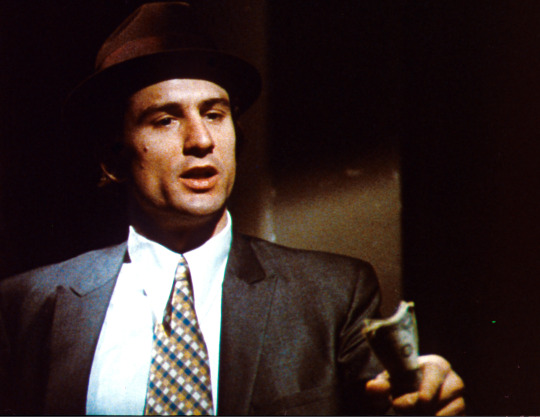
In the brilliant seven-minute opening of MEAN STREETS, we understand that we are entering a new sort of crime film. The gangsters here don’t wear suits or talk like Edward G. Robinson. They’re people like Johnny Boy – an immature, impulsive man who we first see blowing up a mailbox for no ostensible reason; or Charlie – a man searching for meaning in a spiritually bankrupt world. Scorsese shows us these men’s weaknesses and vulnerabilities, though they may try to hide them from themselves and from each other. These complicated characters are unusual for a genre known for its archetypes, but MEAN STREETS was primarily influenced not by classic film noir but by Italian neorealist films, like Fellini’s I Vitelloni (‘53), which is less focused on eventful plot points and instead explores its characters and their everyday lives. With MEAN STREETS and throughout his career, Scorsese moved the crime genre in a new, more interesting direction.
Similarly, ALICE DOESN’T LIVE HERE ANYMORE draws on the traditions of Hollywood melodrama but subverts them with a distinctly modern sensibility. This is epitomized in the opening scene, when we meet the protagonist, Alice, as a young girl. The scene takes place on a wildly artificial set reminiscent of The Wizard of Oz (‘39), but the saccharine atmosphere is undermined by blunt dialogue that would never be heard in a 1930s movie. This scene’s stylistic incongruity mirrors the overarching style of the film: Modern elements are presented within an antiquated context. Part of the brilliance of ALICE DOESN’T LIVE HERE ANYMORE is how, within the framework of the 1950s melodrama genre, Scorsese explores ideas that are completely antithetical to 1950s values.

Though the film, with its shocking turns of events and heightened emotion, is certainly influenced by the melodrama genre, Alice is not at all a typical melodrama protagonist. Like the primary audience of 1950s melodramas, she is a housewife, but she is discontent and dreams of a more meaningful life for herself. When her husband is killed in a car accident, she moves to Arizona to pursue her dream of becoming a singer while raising her son. She ends up working at a diner, where she meets a man named David. She eventually falls in love with David, but this is by no means a glamorous love story. Alice is resistant at first – she’s not a desperate romantic looking for a man, but a skeptical woman who has been hurt before. Scorsese shows us that Alice and David are not perfect people, but that they are two human beings. With ALICE DOESN’T LIVE HERE ANYMORE, Scorsese takes the melodrama genre—which was so often used to portray shallow romances and reinforce postwar gender roles—and instead uses it to tell a nuanced love story with a complex female protagonist.
Recently, Scorsese was criticized for saying that modern superhero movies are “not cinema,” and that they’re more like “theme parks.” Though this may seem like a harsh statement, it’s easy to understand why the director of films like ALICE DOESN’T LIVE HERE ANYMORE and MEAN STREETS doesn’t think much of superhero movies. Scorsese, along with many other directors, revitalized Hollywood by breaking away from the formulas and creating something new. Generally, superhero movies simply serve our desires for what is familiar and comfortable without offering any artistic vision or creativity at its forefront. Many people can make a movie that will be profitable, but very few people can make a movie that will stand the test of time. These two films are just as interesting, smart, funny, heartbreaking and fresh today as they were when they were released over 40 years ago.
#Martin Scorsese#Mean Streets#Alice Doesn't Live Here Anymore#New Hollywood#director#1970s#Ellen Burstyn#TCM#Turner Classic Movies
88 notes
·
View notes